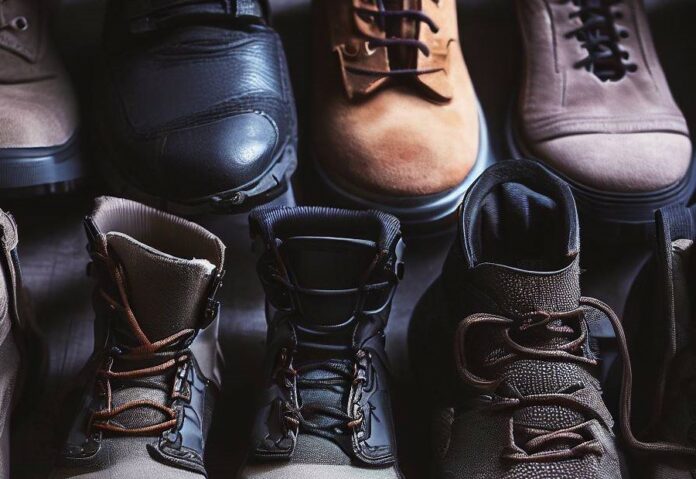Learning how to choose tactical boots is crucial for anyone in professions that require strenuous physical activity or for outdoor enthusiasts who demand durable and reliable footwear. The right pair of tactical boots can provide the necessary support, protection, and comfort needed in challenging environments.
In order to make an informed decision, it is important to consider various factors when choosing tactical boots, such as durability, comfort and fit, material and construction, traction and grip, support and stability, waterproofing, breathability, weight, and style and aesthetics. These factors will ensure that the boots are suitable for your specific needs and will withstand the demands of your activities.
Furthermore, understanding the different types of tactical boots available is essential. Common types include combat boots, hiking boots, training and running shoes, and specialized boots like desert boots or jungle boots. Each type is designed for specific purposes and environments, so it is important to choose accordingly.
Finally, trying and testing the boots is highly recommended before making a final decision. Walking in them, checking for proper fit and comfort, and assessing their performance in different terrains and conditions will help you determine if they meet your expectations.
By considering these factors, understanding the different types, and testing the boots, you can confidently select the right tactical boots that will support you throughout your demanding activities.
Importance of Choosing the Right Tactical Boots
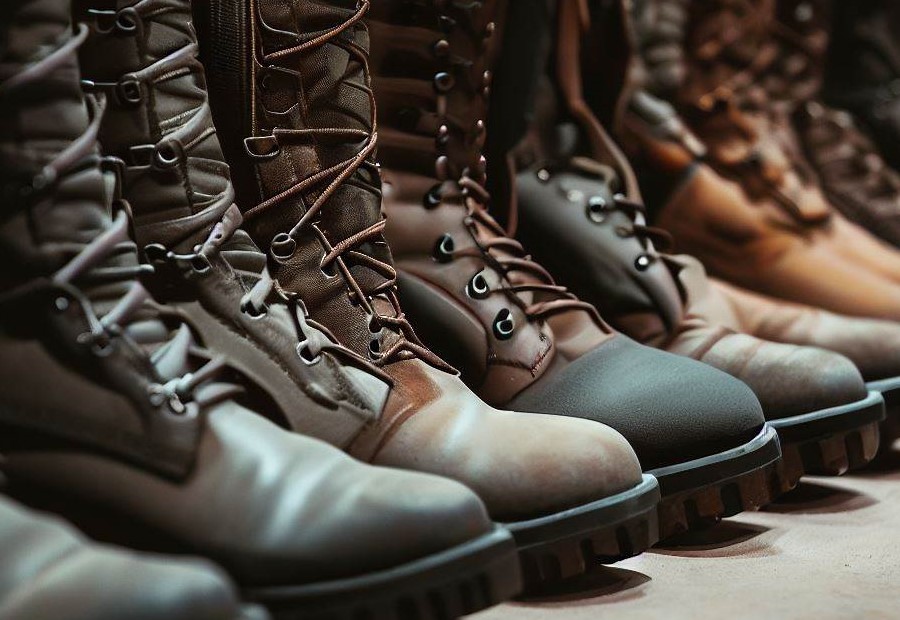
Choosing the right tactical boots is crucial for a variety of reasons. Firstly, it is of utmost importance to enhance the performance and effectiveness of the wearer during tactical operations. The boots should have well-designed features like ankle support and slip-resistant soles, which can significantly improve agility and stability in high-intensity situations.
Secondly, selecting the appropriate tactical boots can play a vital role in the prevention of injuries and the promotion of overall well-being. Boots with reinforced toe caps and cushioning offer protection against impacts and reduce the risk of foot fatigue, allowing the wearer to comfortably carry out their duties.
Moreover, the right boots can also foster proficiency by providing functional features such as waterproofing, breathability, and compatibility with accessories like knife pockets or communication devices. These elements contribute to the overall efficiency and effectiveness of the wearer, especially in challenging environments.
Lastly, it is essential to consider the specific requirements of the mission or task at hand when choosing tactical boots. Different tactical operations may demand specific features in boots, such as insulation for cold climates or lightweight construction for swift movements. By considering these factors, individuals can ensure they have the most suitable boots for their needs.
Factors to Consider on How to Choose Tactical Boots
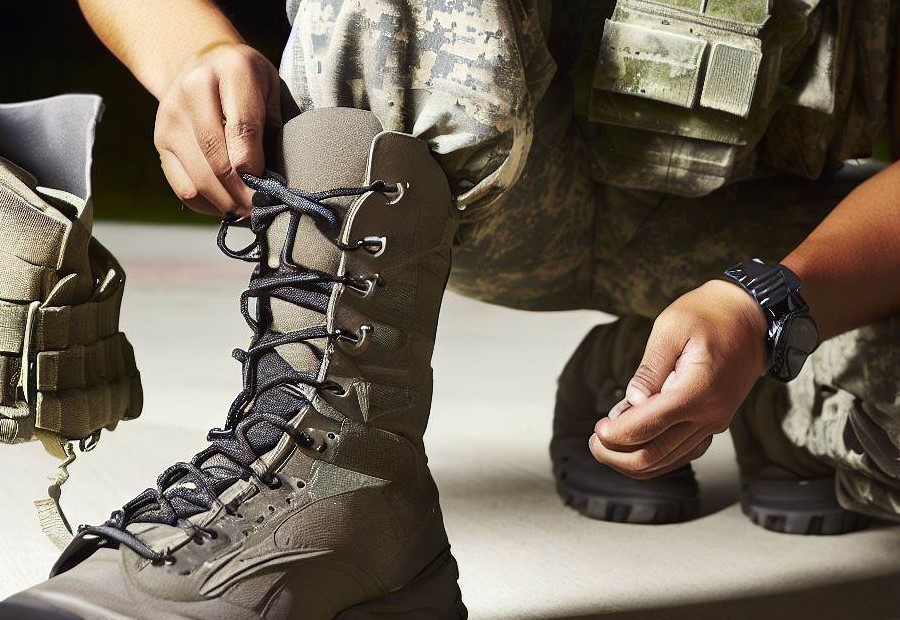
When it comes to choosing tactical boots, there are several important factors to consider. From durability and comfort to traction and waterproofing, each attribute plays a crucial role in finding the perfect pair. In this section, we will dive into the key considerations when selecting tactical boots. Whether you prioritize support and stability or value the breathability and weight, we’ve got you covered. So let’s explore the factors that will ensure your tactical boots meet your specific needs and preferences.
Durability
Incorporating durability into the selection of tactical boots is crucial, as they must be able to withstand rigorous activities and various environments. When choosing tactical boots, consider the following key aspects:
| 1. | Quality of Materials | Ensure that the boots are made from high-quality materials such as full-grain leather or durable synthetic fabrics. These materials should possess the capability to resist wear and tear and withstand abrasions. |
| 2. | Reinforced Construction | Look for boots with reinforced stitching, particularly in areas that experience significant stress, such as the toe cap and heel. Double or triple stitching can provide additional strength and durability. |
| 3. | Protective Toe | Consider boots that feature a protective toe cap, which is usually made of composite or steel, to guard against impacts and compression. |
| 4. | High-Traction Outsole | Choose boots with a slip-resistant outsole that offers excellent traction on different terrains. Look for deep treads and a durable rubber compound. |
| 5. | Water and Abrasion Resistance | Make sure the boots have a waterproof or water-resistant membrane, such as Gore-Tex, to keep your feet dry in wet conditions. Additionally, select boots with features that resist abrasion to protect against damage from rough surfaces. |
| 6. | Proper Fit | Remember to choose boots that fit well, as a proper fit enhances durability. Boots that are too tight or too loose can cause premature wear and discomfort. |
Taking these factors into consideration will assist you in selecting a pair of tactical boots that provide durability and longevity. These boots will offer the necessary support and protection, enabling you to focus on your tasks without concerns about footwear problems.
Comfort and Fit
When considering comfort and fit while choosing tactical boots, it is essential to prioritize factors that directly affect your experience wearing them. Sizing is an important aspect to ensure comfort and avoid potential injuries.
Ill-fitting boots can cause blisters, hot spots, and overall discomfort. Additionally, cushioning plays a crucial role in providing support and comfort, particularly in the heel and arch areas. Adequate cushioning helps absorb impact and makes extended periods of wear more comfortable.
Proper ankle support is essential to prevent ankle sprains and injuries. It is recommended to look for boots with high-quality ankle support to ensure stability and reduce the risk of twisting or rolling your ankles. Furthermore, finding boots with a good balance of flexibility and rigidity is important. Boots that are too stiff may restrict natural foot movement, while boots that are too flexible may lack support.
A secure and adjustable lacing system is beneficial as it allows you to customize the fit of your boots according to your preference and foot shape. This helps prevent slipping and ensures a snug fit, enhancing both comfort and fit.
Breathability is another crucial factor to consider. Opting for boots that promote airflow and reduce moisture buildup can keep your feet dry and comfortable. Look for breathable materials and ventilation features, such as mesh panels, to enhance comfort and reduce sweating.
It’s important to keep in mind that most boots require a break-in period to mold to your feet. The duration of this period may vary based on the boots’ materials and construction. Therefore, it is recommended to allow sufficient time to ensure a comfortable fit before engaging in demanding activities.
By prioritizing comfort and fit when selecting tactical boots, you can focus on your tasks without unnecessary distractions or discomfort.
Material and Construction
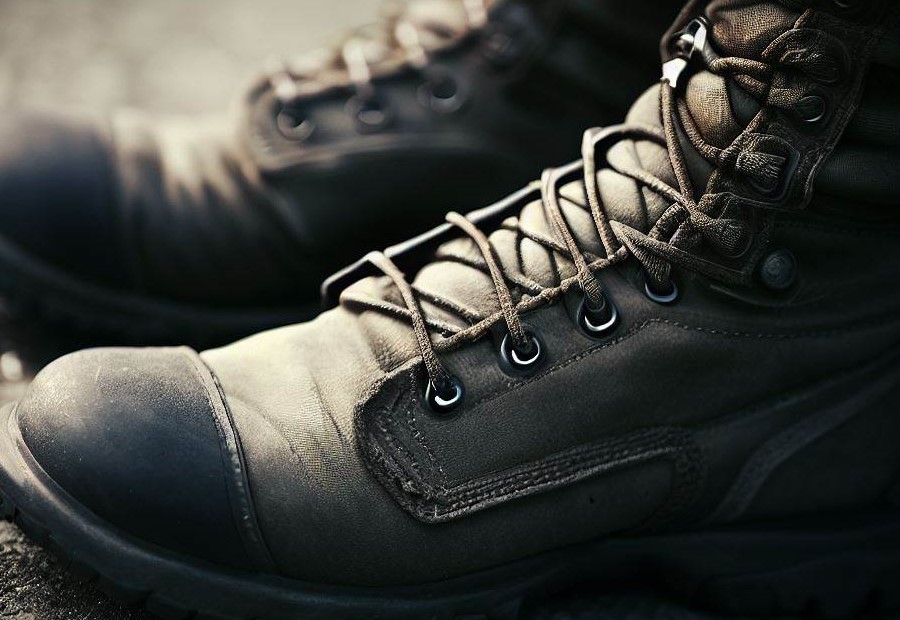
When it comes to selecting the right tactical boots, the material and construction are essential factors to consider. The material utilized in the boots determines their durability, comfort, and performance. Common materials include full-grain leather, nylon or synthetic fabrics, suede or nubuck leather, and rubber or polyurethane.
The construction of the boots also plays a significant role in their overall quality. For durability, it is preferred to have stitched or welted construction as it provides a strong bond between the upper and sole.
Lightweight boots often feature cement or adhesive construction, while direct attach construction offers flexibility. For waterproofing, boots with vulcanized or injection-molded construction are recommended.
By paying attention to the material and construction of tactical boots, you can ensure that you choose a pair that meets your specific needs and requirements. Remember to consider factors such as the intended use, environment, and personal preferences when making your decision.
Traction and Grip
When it comes to choosing the right tactical boots, traction and grip are essential factors to consider. These features can greatly affect your performance and safety in various environments. Here are some points to keep in mind:
- The outsole material: Look for boots with rubber or synthetic outsoles that provide excellent traction and grip on different surfaces. These materials offer superior grip and can prevent slips and falls.
- Tread pattern: A deep and multidirectional tread pattern enhances traction and grip by providing more contact points with the ground. It helps you maintain stability and prevents you from losing your footing.
- Oil and slip resistance: Ensure that the boots have oil and slip-resistant properties. This feature is crucial, especially in wet or oily conditions, as it reduces the risk of accidents and allows you to maintain control.
- Flexibility: Boots with a flexible sole and midsole allow for better movement and adaptability to uneven terrains. They enable your feet to grip the ground more effectively, enhancing overall traction and grip.
One time, during a training exercise in muddy terrain, a soldier wearing boots with poor traction and grip slipped and fell, injuring himself. Since then, he has realized the importance of choosing tactical boots with excellent traction and grip. He now prioritizes this feature to ensure his safety and performance in challenging environments.
Support and Stability
Support and stability are crucial factors to consider when choosing tactical boots. These boots are designed to provide the necessary support and stability for demanding activities.
1. High-quality materials: Look for boots made of durable and sturdy materials like leather or nylon. These materials offer excellent support and stability.
2. Reinforced ankle support: Ankle support is essential for stability, especially during intense physical activities. Look for boots with reinforced ankle support to prevent injuries and ensure stability.
3. Firm and stable sole: The sole of the boot should be firm and provide good traction. This will help you maintain stability on various terrains, even in slippery conditions.
4. Proper arch support: Adequate arch support is vital for stability and preventing foot fatigue. Choose boots with built-in arch support or opt for aftermarket insoles for added stability.
5. Lacing system: A secure and adjustable lacing system is crucial for achieving a proper and snug fit. This will enhance stability, as your feet will be securely held in place.
6. Reinforced toe cap: A reinforced toe cap provides additional protection and stability, especially in hazardous environments. Look for boots with a solid and durable toe cap.
Remember that support and stability can vary depending on the activities you’ll be engaging in. Consider the specific requirements of your intended use, whether it’s for military operations, hiking, or training. Ensure the boots meet your specific needs for support and stability.
By considering these factors, you can choose tactical boots that offer the right support and stability for your activities, keeping you comfortable and safe on your adventures.
Waterproofing
The importance of waterproofing in tactical boots cannot be overstated. Here are some factors to consider when evaluating the waterproofing capabilities of tactical boots:
- Material and construction: Look for boots made with waterproof materials such as Gore-Tex or waterproof leather. These materials create a barrier that prevents water from seeping into the boot.
- Seam sealing: Check if the boots have sealed seams. Sealed seams ensure that water cannot enter through any stitching or seams in the boot.
- Membrane technology: Many tactical boots utilize membrane technology to provide waterproofing. This technology allows moisture to escape while preventing water from entering, keeping your feet dry.
- Water resistance rating: Some boots may come with a water resistance rating. Look for boots with a high rating, such as IPX7, which means they are capable of withstanding immersion in water up to 1 meter for 30 minutes.
- Testing and reviews: Consider reading reviews and conducting your own testing if possible. Look for feedback on how the boots perform in wet conditions and if they effectively keep water out.
Remember, proper care and maintenance of your tactical boots can also enhance their waterproofing abilities. Regularly clean and treat the boots with waterproofing sprays or conditioners to ensure they remain water-resistant for longer periods. Waterproof boots are essential for keeping your feet dry and comfortable in wet and challenging conditions.
Weight
The weight of tactical boots is a key consideration when choosing the right pair for your needs. It can significantly impact your comfort, mobility, and overall performance. To help you make an informed decision, here is a table displaying the weight range of different types of tactical boots:
| Tactical Boot Type | Weight Range (per boot) |
| Combat Boots | 1.5 – 3.5 lbs |
| Hiking Boots | 1 – 2.5 lbs |
| Training and Running Shoes | 0.5 – 1.5 lbs |
| Specialized Boots | 1 – 3 lbs |
When considering weight, it’s crucial to find the right balance between durability and agility. While a heavier boot can provide more protection and support, it may also become tiresome to wear for extended periods and restrict your mobility. Conversely, a lighter boot might offer greater flexibility and freedom of movement, but it could potentially sacrifice durability and impact protection.
Ultimately, the weight of tactical boots depends on your specific needs and preferences. If maximum protection and stability are paramount, opting for slightly heavier combat boots may be suitable. However, if agility and speed are crucial, selecting a lighter option like training and running shoes could prove more advantageous.
Fact: The weight of tactical boots can vary significantly based on the materials used, construction techniques, and intended purpose.
Style and Aesthetics
When choosing tactical boots, style and aesthetics are important factors to consider. The appearance of the boots can greatly impact your overall confidence and comfort while wearing them. Here are some key aspects to keep in mind:
- Design: It is crucial to choose a design that aligns with your personal style preferences and the intended use of the boots. Tactical boots come in various designs, including classic military-style, modern sleek designs, and camouflage patterns.
- Color: Consider the color of the boots based on your preferences and the environment where you will be wearing them. Black is a versatile and popular option for tactical boots, while tan or coyote brown may blend well in desert environments.
- Material: Look for boots made from durable and high-quality materials that not only provide functionality but also contribute to the overall aesthetics. Commonly used materials in tactical boots include full-grain leather, synthetic fabrics, and nylon.
- Details and accents: Pay attention to the details and accents on the boots, such as stitching patterns, logos, and additional features. These can add personality and style to your boots.
- Brand reputation: Consider the reputation of different brands for their style and aesthetic choices. Some brands may have a more traditional or rugged style, while others may offer a more modern and trendy look.
Remember that while style and aesthetics matter, it is crucial to prioritize functionality, durability, and comfort when choosing tactical boots. Finding a balance between style and practicality will ensure that you have boots that not only look good but also perform well in demanding situations.
Types of Tactical Boots
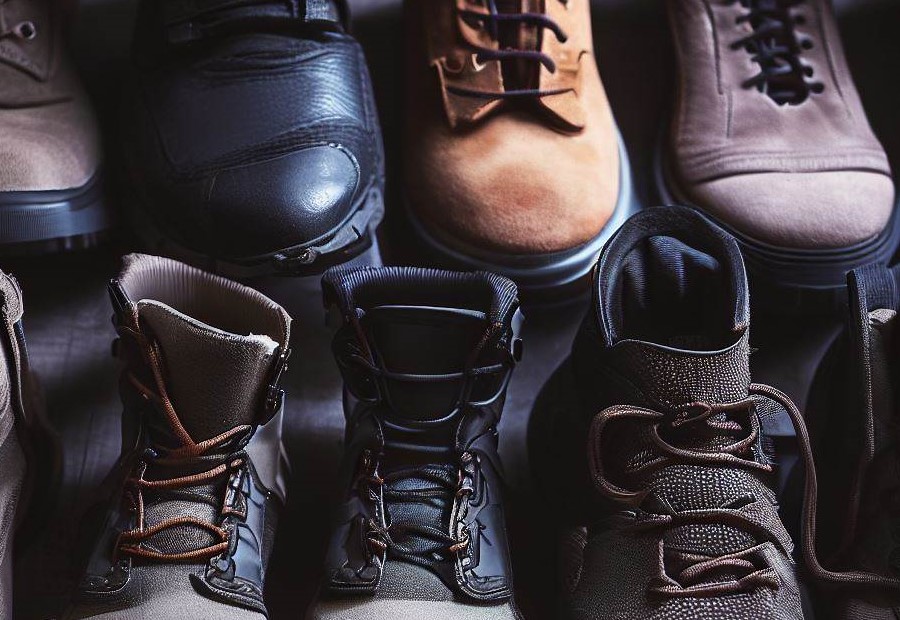
When it comes to choosing tactical boots, understanding the different types is crucial. From combat boots to hiking boots, training and running shoes to specialized boots, each sub-section offers unique features and benefits. Whether you need rugged durability, enhanced support, or specialized functionality, knowing the distinctions will help you make an informed decision. So let’s dive into the world of tactical boots and explore the various types that are available.
Combat Boots
Combat boots are well-regarded for providing excellent protection to the wearer. These boots are constructed using thick and durable materials, ensuring they can withstand tough environments and safeguard against impact, abrasions, and punctures. Moreover, combat boots are renowned for their exceptional durability and ability to endure rigorous use and harsh conditions, guaranteeing that they will last for a long time.
Good traction is imperative for combat boots, considering they are often utilized in slippery or uneven terrains. Combat boots typically possess rugged outsoles with deep lugs, ensuring they offer excellent grip and stability.
Additionally, combat boots offer high ankle support, a crucial feature for preventing injuries during intense physical activities. The design of combat boots helps stabilize the ankle and minimizes the risk of twists or sprains.
Many combat boots come equipped with waterproof or water-resistant features, making them ideal for military personnel who may be exposed to wet environments or adverse weather conditions.
Therefore, when selecting combat boots, it is essential to consider the specific needs and requirements of your activities. Choose boots that are suitable for the terrain, climate, and purpose to ensure optimal performance and comfort.
Hiking Boots
When it comes to outdoor activities, hiking boots are a must-have gear for any enthusiast. The choice of the right hiking boots is essential, and there are different factors to consider.
- Durability: It is important to choose hiking boots that are tough and can withstand the challenges of the trail. Look for boots that are made with high-quality materials and have sturdy construction.
- Comfort and Fit: The proper fit of hiking boots is crucial. They should provide ample support, have a cushioned insole, and offer a snug fit without being too tight. Opt for boots with adjustable lacing systems to ensure a customized fit.
- Traction and Grip: Hiking boots should have excellent grip on different terrains. Look for boots with lugged soles or multidirectional tread patterns to enhance traction.
- Support and Stability: Ankle support is essential to prevent sprains or injuries while hiking. Look for boots with reinforced ankle collars and solid midsoles to ensure stability.
- Waterproofing: Hiking boots should be able to withstand wet conditions. Choose boots with waterproof membranes or treated uppers to keep your feet dry.
- Breathability: To prevent sweaty and uncomfortable feet, hiking boots should allow moisture to escape. Look for boots with breathable materials and ventilation features.
- Weight: Consider the weight of the hiking boots. Lighter boots make movement on the trail easier and more comfortable.
- Style and Aesthetics: While not crucial for performance, the style and aesthetics of hiking boots can be a personal preference. Choose a design that suits your taste and outdoor style.
When choosing hiking boots, make sure they meet your specific needs based on the intensity and duration of your hikes. Take the time to try on different boots and walk around to test their comfort and fit.
Remember, finding the perfect pair of hiking boots can greatly enhance your outdoor experience and keep your feet happy and protected.
Training and Running Shoes
- Comfort: When it comes to training and running shoes, one of the key features you should look for is comfort. Adequate cushioning and support are essential to ensure a comfortable experience during physical activities. Make sure to find shoes with responsive midsoles and padded insoles.
- Fit: Proper fit plays a vital role in preventing discomfort and injuries. It is crucial to choose shoes that fit snugly and provide ample space for toe movement. Consider trying different sizes or widths to find the perfect fit for you.
- Durability: Since training and running shoes go through frequent wear and tear, it is important to select a durable pair. Look for shoes that are made with sturdy materials and reinforced stitching to ensure they are built to last.
- Traction: Good traction is necessary to avoid slipping and provide stability during running or training sessions. Check for shoes that have rubber outsoles and multidirectional tread patterns to ensure excellent grip.
- Breathability: Engaging in physical activities can cause your feet to sweat. To keep your feet cool and dry, look for shoes with breathable uppers made from mesh or perforated materials. This will enhance airflow and minimize discomfort.
Pro-tip: It is recommended to try on training and running shoes later in the day when your feet are slightly swollen. This will give you a better idea of how they will fit during intense exercise.
Specialized Boots
When it comes to specialized boots, there are options available to cater to specific needs and activities. Here are some important factors to consider:
- Task-specific boots: Specialized boots are designed for specific tasks such as military operations, law enforcement, or firefighting. These specialized boots are built to withstand the rigors and demands of these professions and provide the necessary support and protection.
- Fire resistant boots: For firefighters or those working in environments with high heat or flames, specialized fire-resistant boots are essential. These specialized boots are made from materials that can withstand extreme temperatures and provide protection against burns.
- Waterproof boots: For outdoor activities or working in wet environments, specialized waterproof boots are crucial. These specialized boots are designed with waterproof materials and sealed seams to keep your feet dry and protected.
- Electrical hazard boots: For those working with electricity or in environments with potential electrical hazards, specialized electrical hazard boots are a must. These specialized boots are designed with insulation and non-conductive materials to protect against electric shocks.
- Tactical boots for extreme conditions: In extreme conditions such as extreme cold or extreme heat, specialized boots with insulation or heat-resistant properties are necessary. These specialized boots provide comfort and protection in these challenging environments.
When choosing specialized boots, it is important to assess your specific needs and select the boots that best meet those requirements. Consider the tasks you’ll be performing, the environments you’ll be working in, and the level of protection and support you need.
Frequently Asked Questions
What are station boots and why are they important in a physically demanding environment?
Station boots are specially designed footwear for firefighters and EMTs that provide protection against foreign objects, chemical spills, and bodily fluids. They are crucial in a physically demanding environment as they offer durability and support during long shifts and are ideal for extended wear.
Which features make tactical boots suitable for heavy-duty situations and rough terrain?
Tactical boots designed for heavy-duty situations and rough terrain should have durable construction, superior support, and a heavy-duty yet flexible and lightweight sole for traction on various surfaces. They should also have a 6 to 8 inch height for ankle support and protection from ground level hazards.
How can the BOA closure system in Blauer boots provide a personalized fit and easy removal?
The BOA closure system is a unique feature in Blauer boots that uses a braided stainless steel cable and a turn of a dial to provide a personalized fit. This system allows users to easily adjust the tightness of the boots for maximum comfort and convenience. It also makes taking off the boots quick and effortless.
What role does a waterproof exterior or membrane play in tactical boots?
A waterproof exterior or membrane is essential in tactical boots as it protects the feet from the weather and prevents moisture buildup. This feature allows perspiration to escape while keeping the feet dry, making it ideal for use in various weather conditions and during extended periods of time.
Why are military boots with steel toes and materials that protect against debris and bodily fluids important for EMTs?
EMTs require highly protective tactical boots that can withstand hazardous working conditions. Boots with safety-rated steel or composite toes provide extra protection against impacts. Furthermore, materials that protect against debris and bodily fluids are crucial for maintaining a hygienic and safe working environment.
What are the uniform regulations for army boots and USMC boots?
Army boots and USMC boots must adhere to specific uniform regulations. Army boots should be coyote brown in color, 8″ in height, with a soft toe and made of flesh-out cattlehide leather. They are regulated by AR 670-1. USMC boots may be olive mojave or coyote brown in color, 8″ in height, and can have a soft or steel toe. They should feature the Eagle, Globe, and Anchor insignia and are regulated by MCO 1020.34H.

